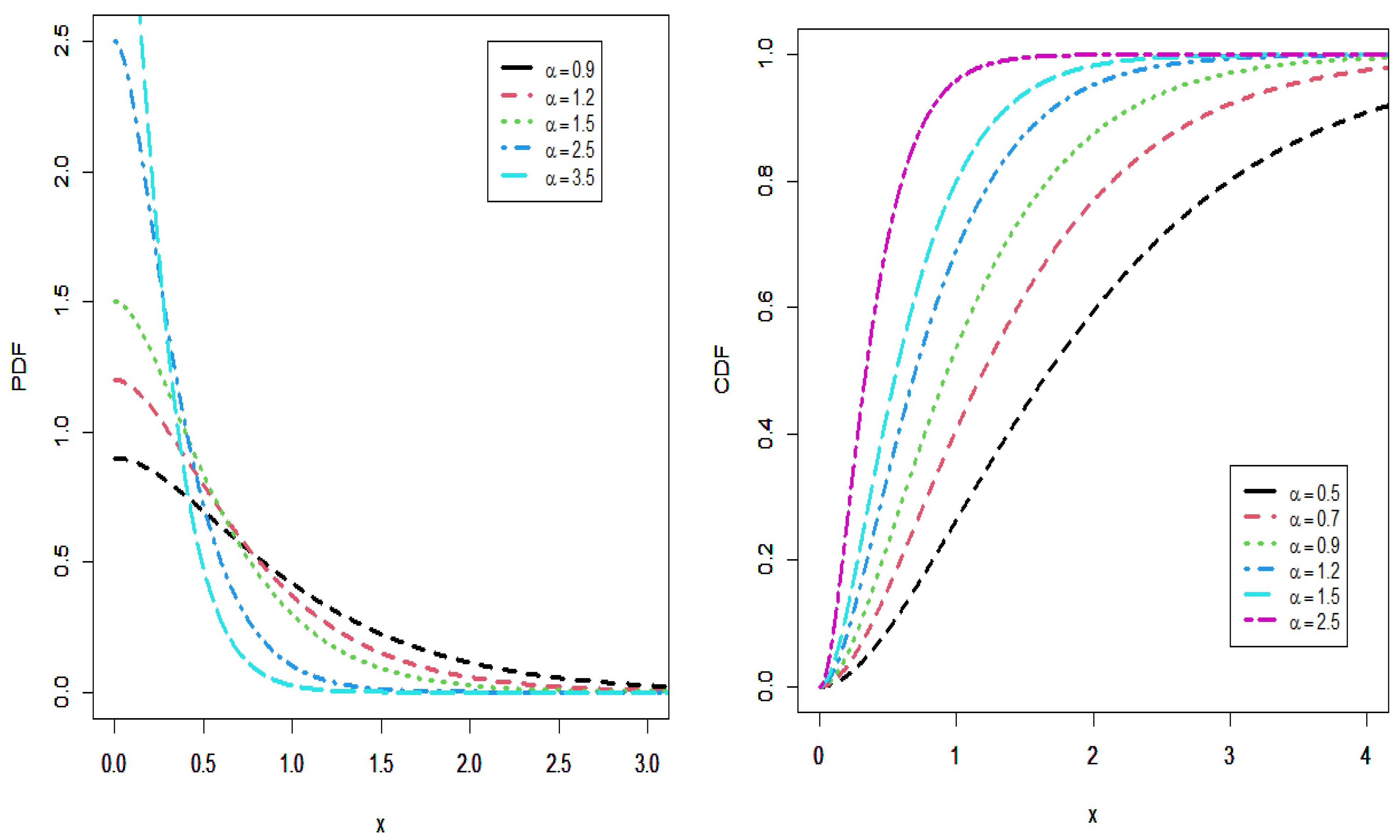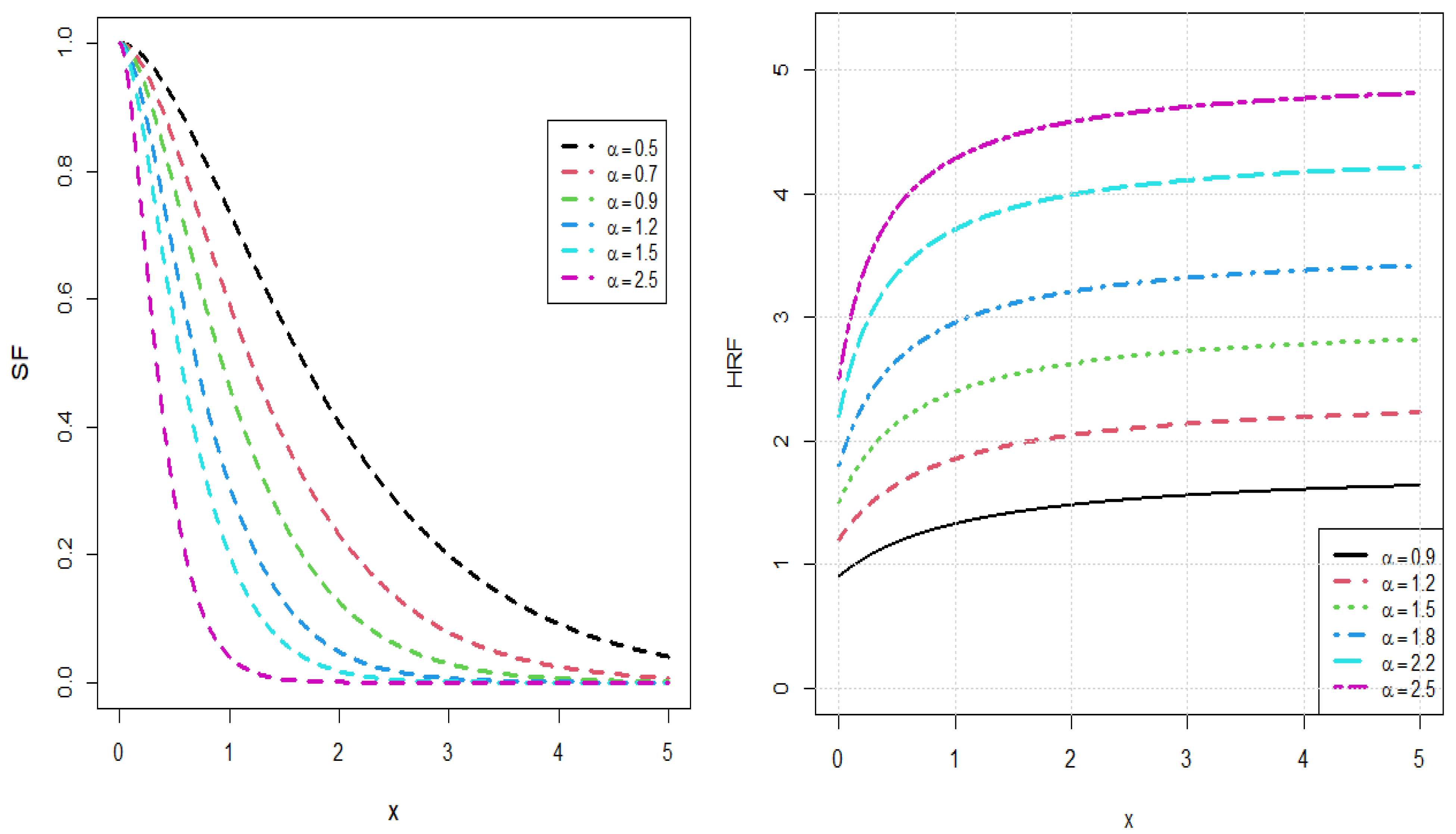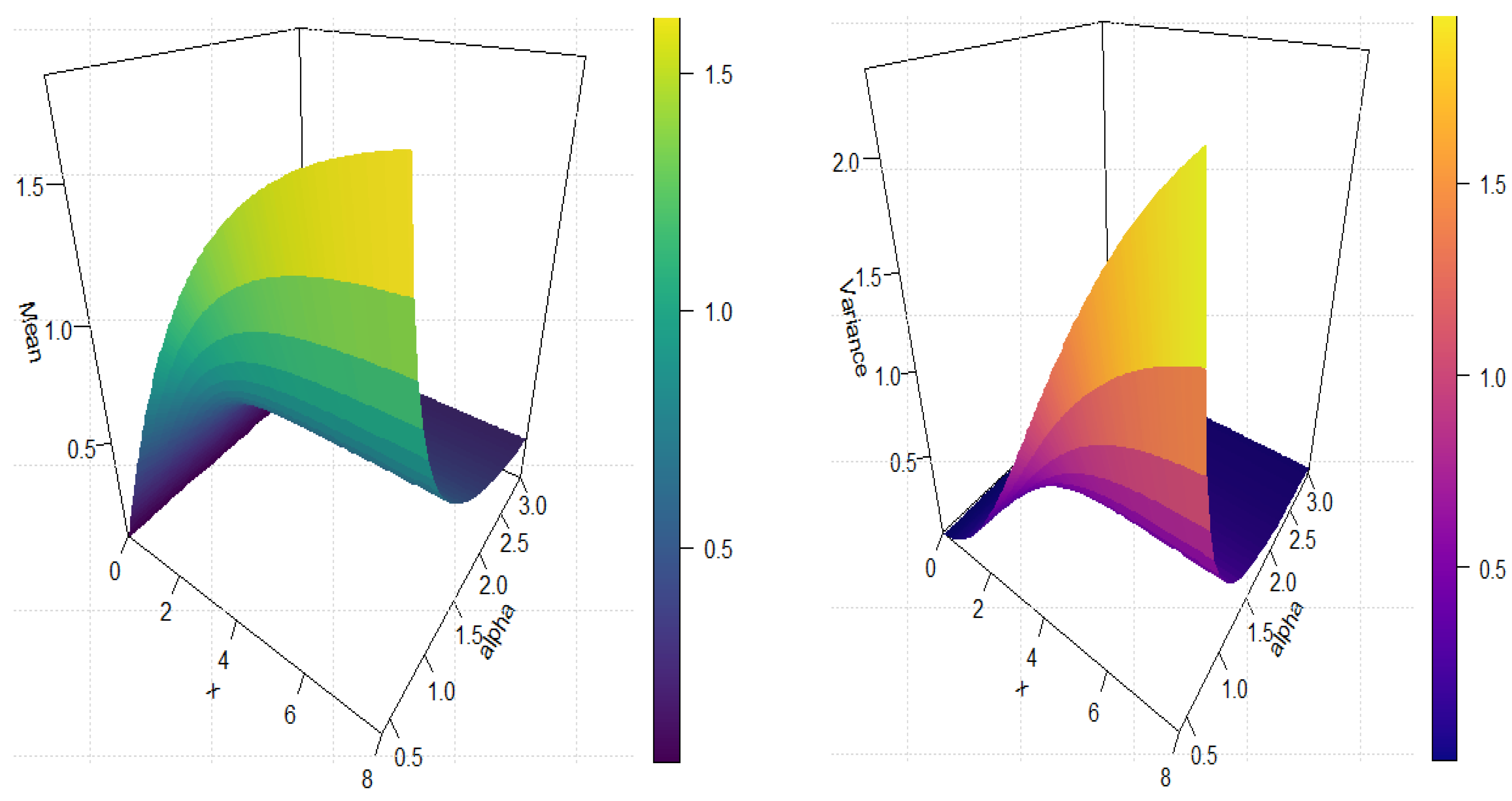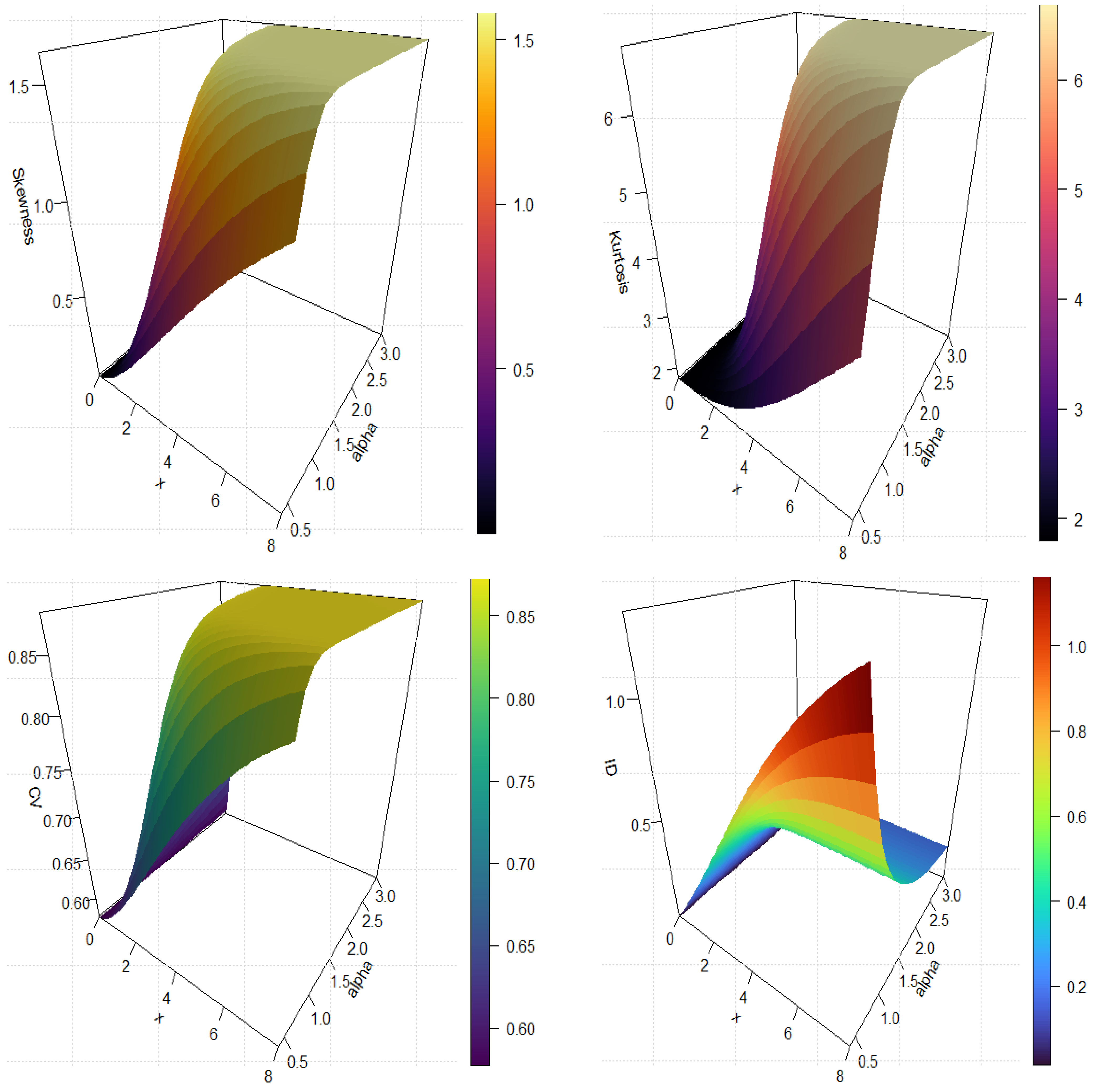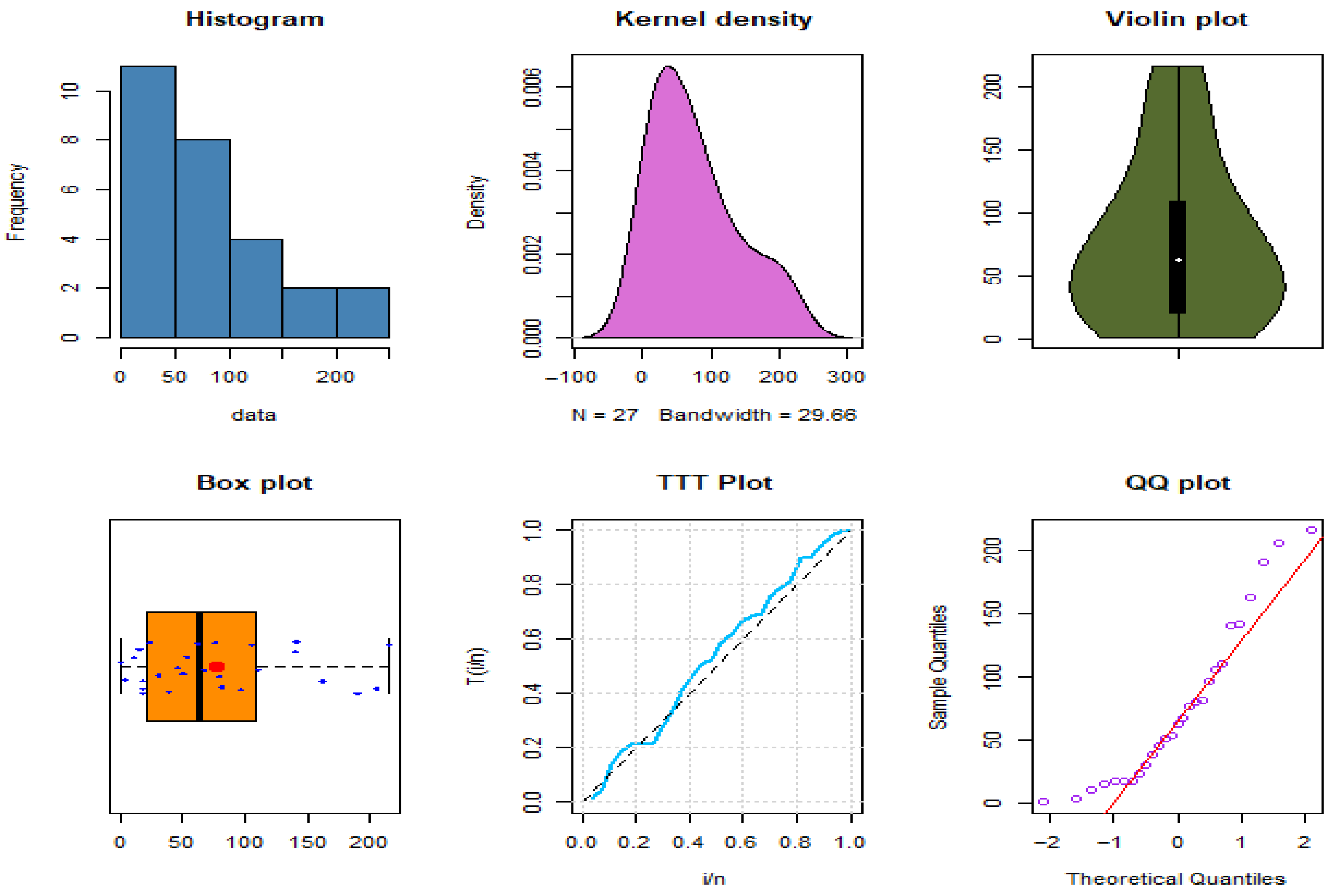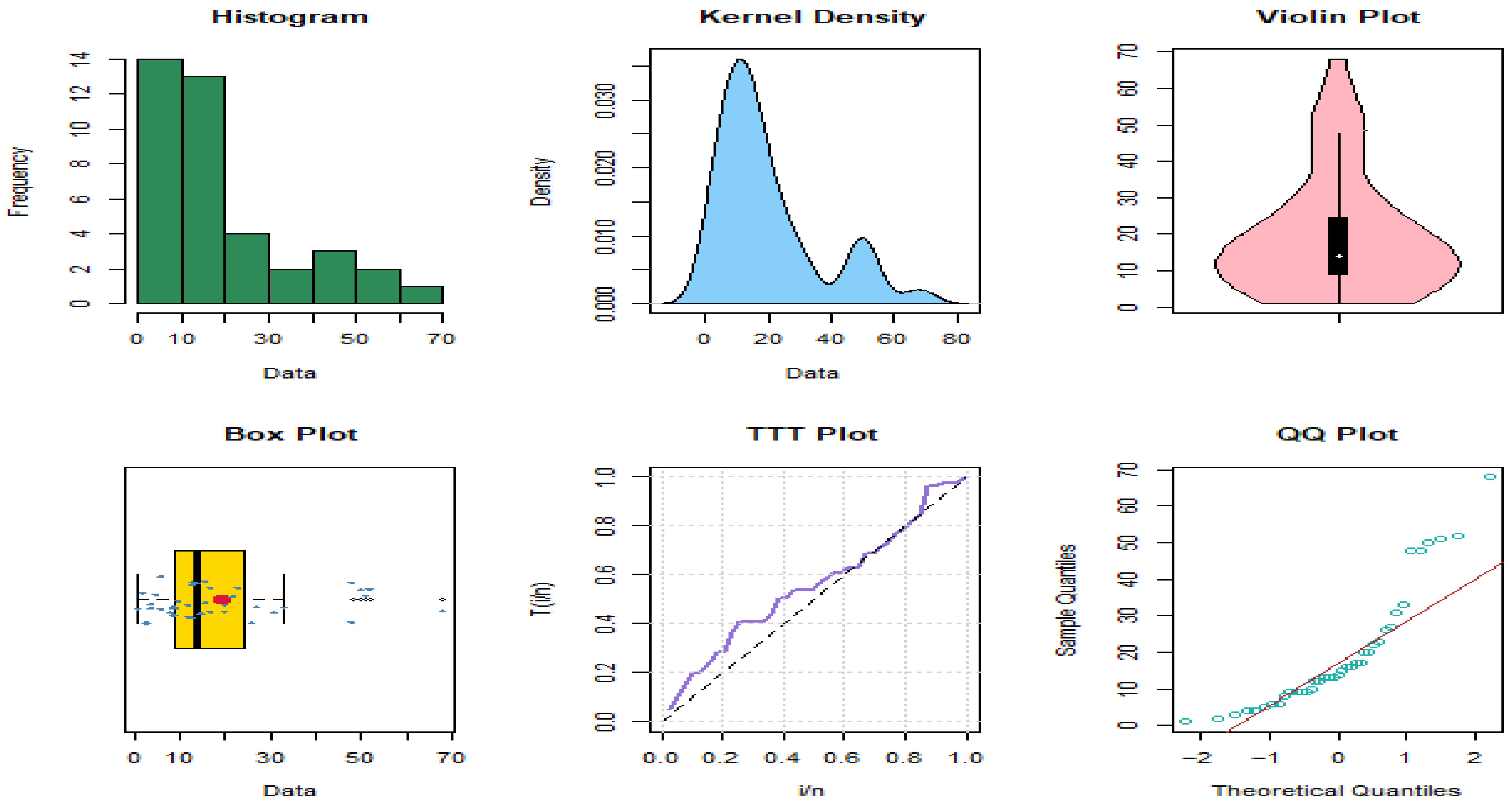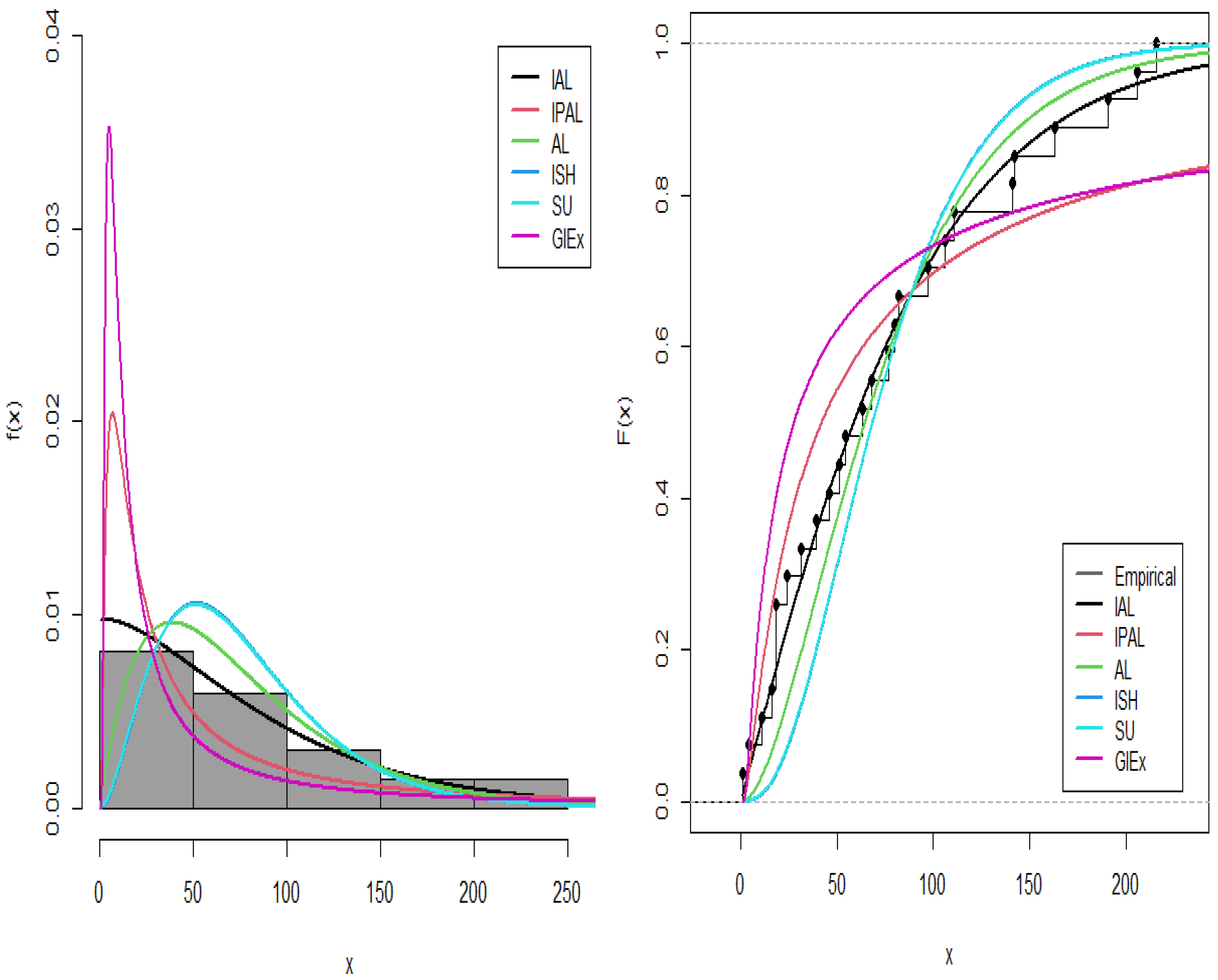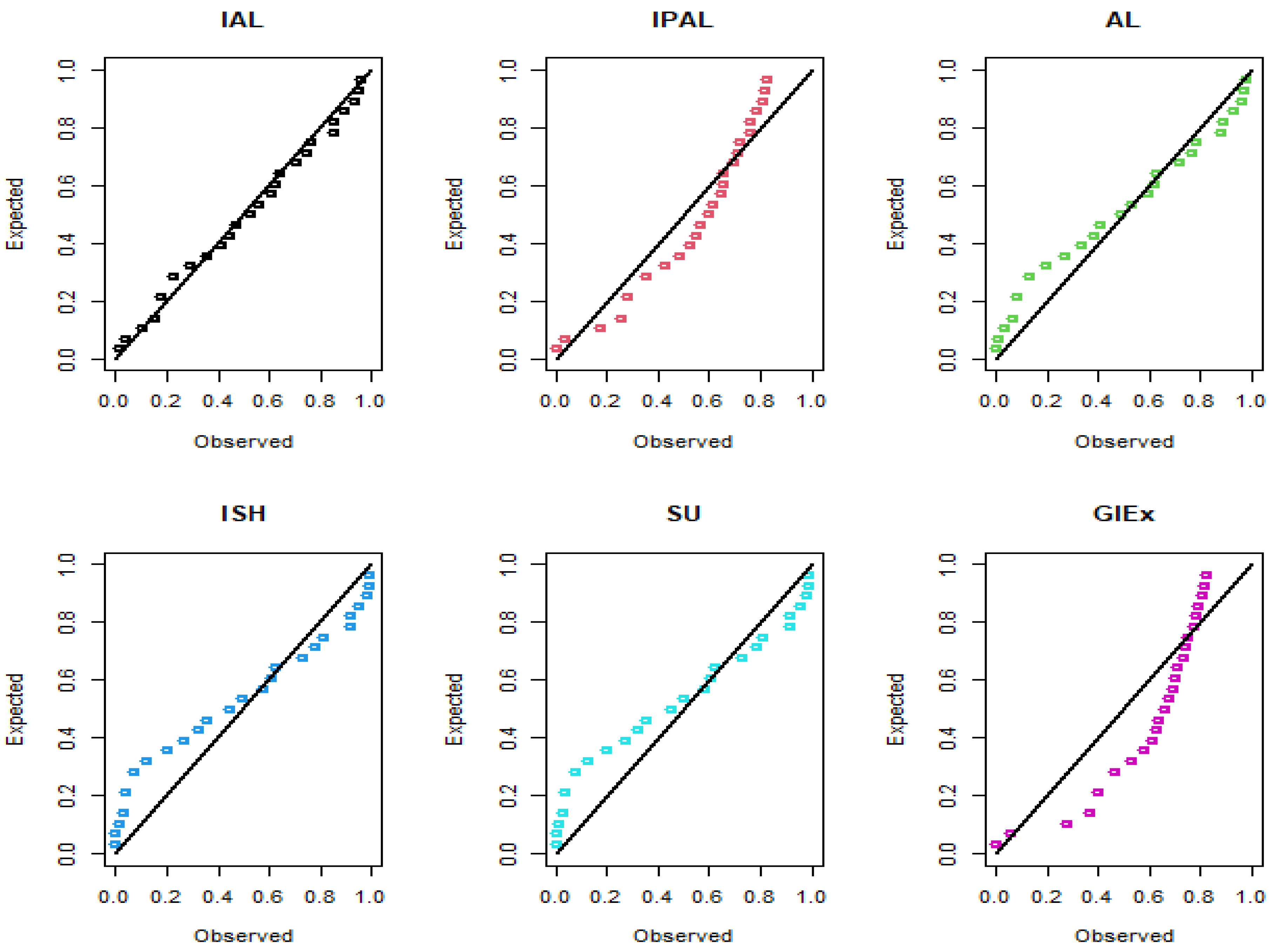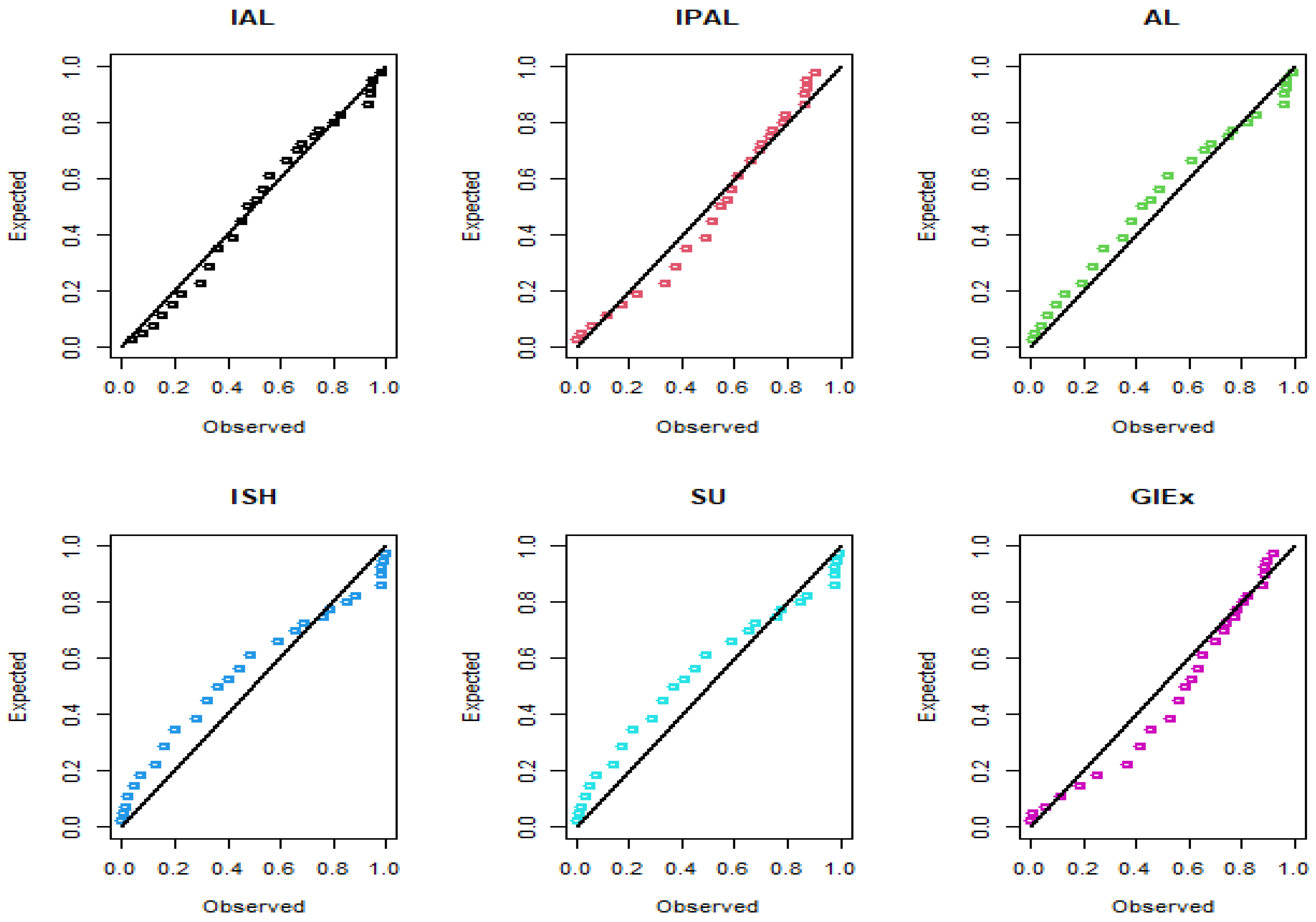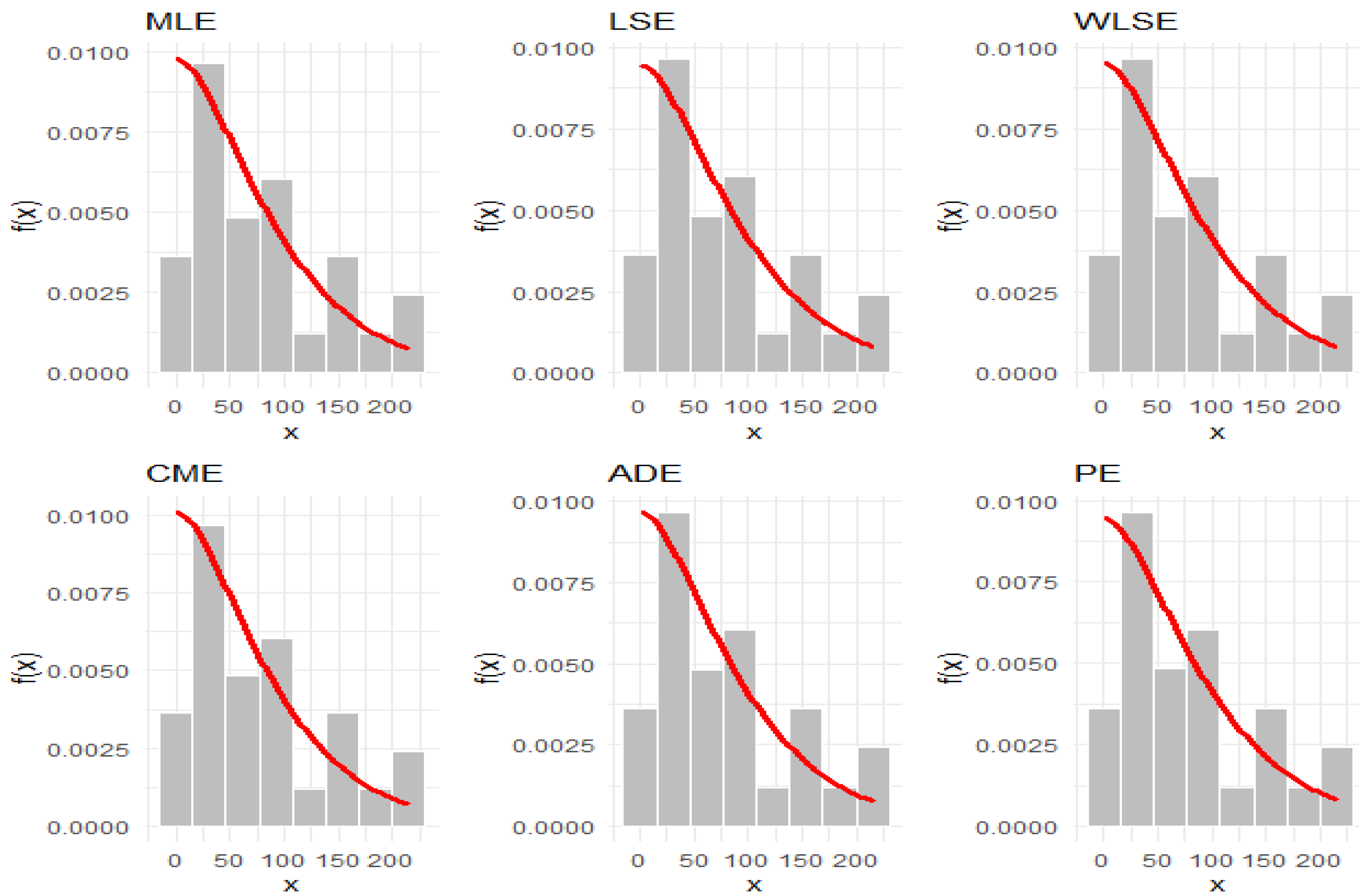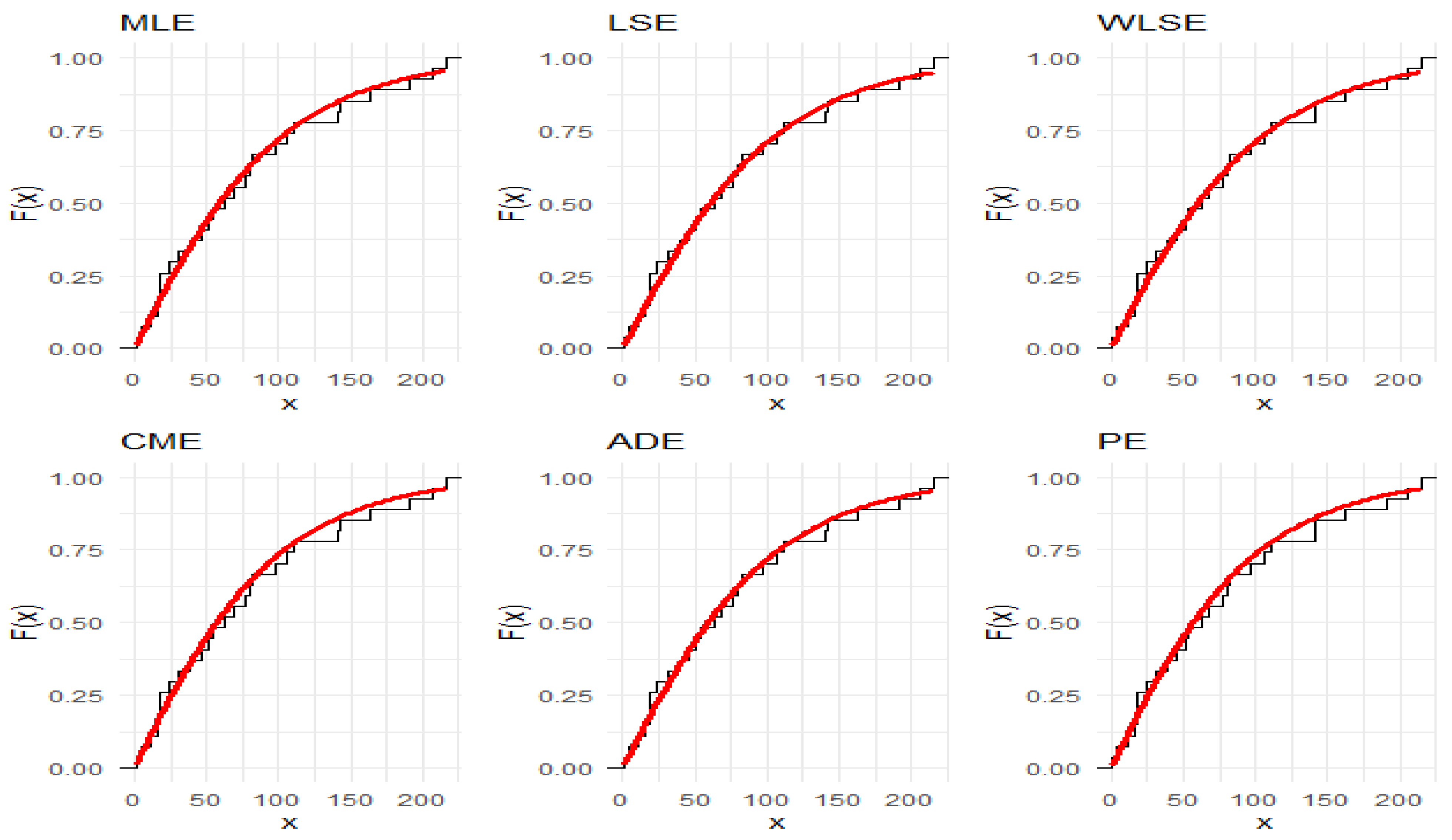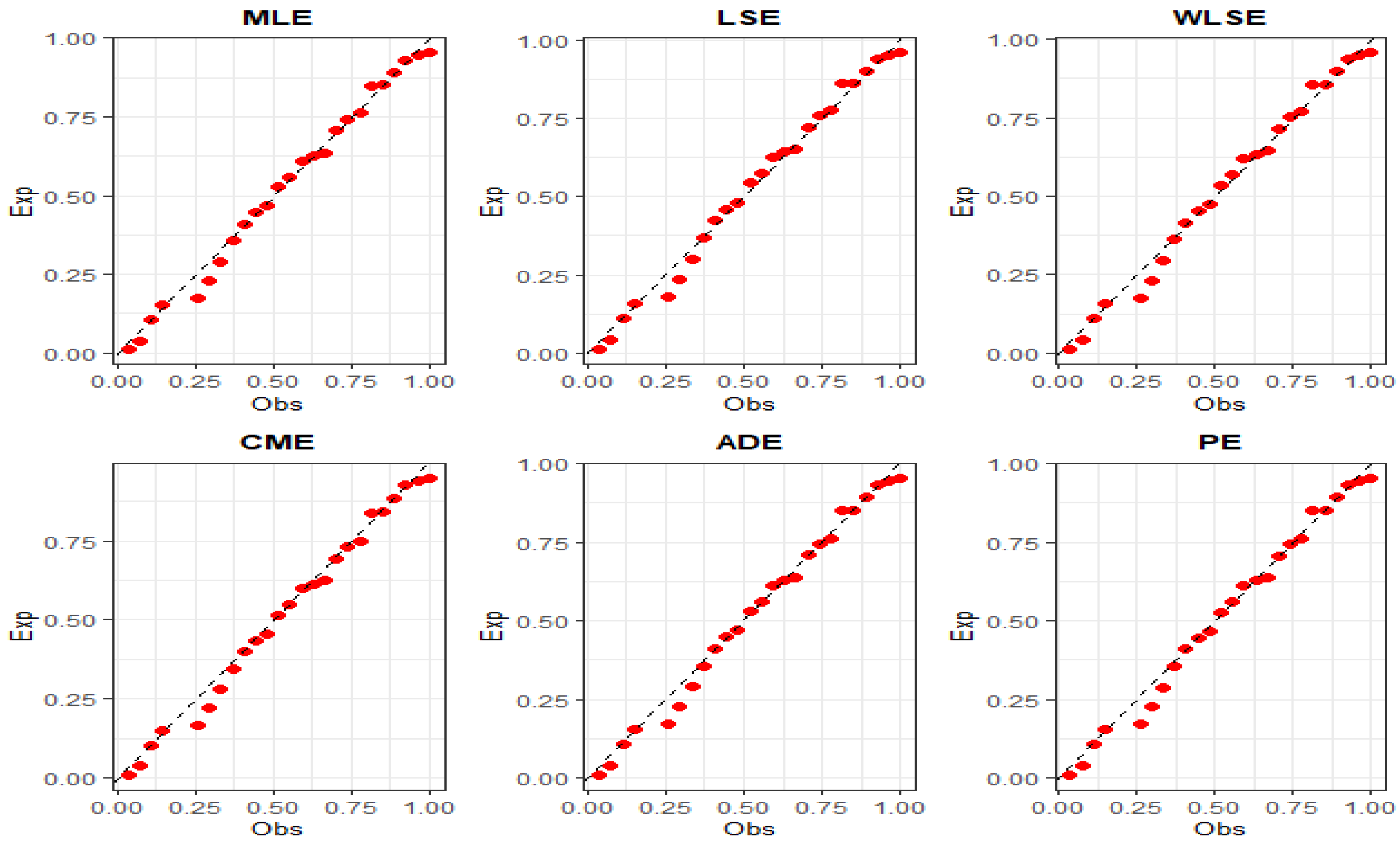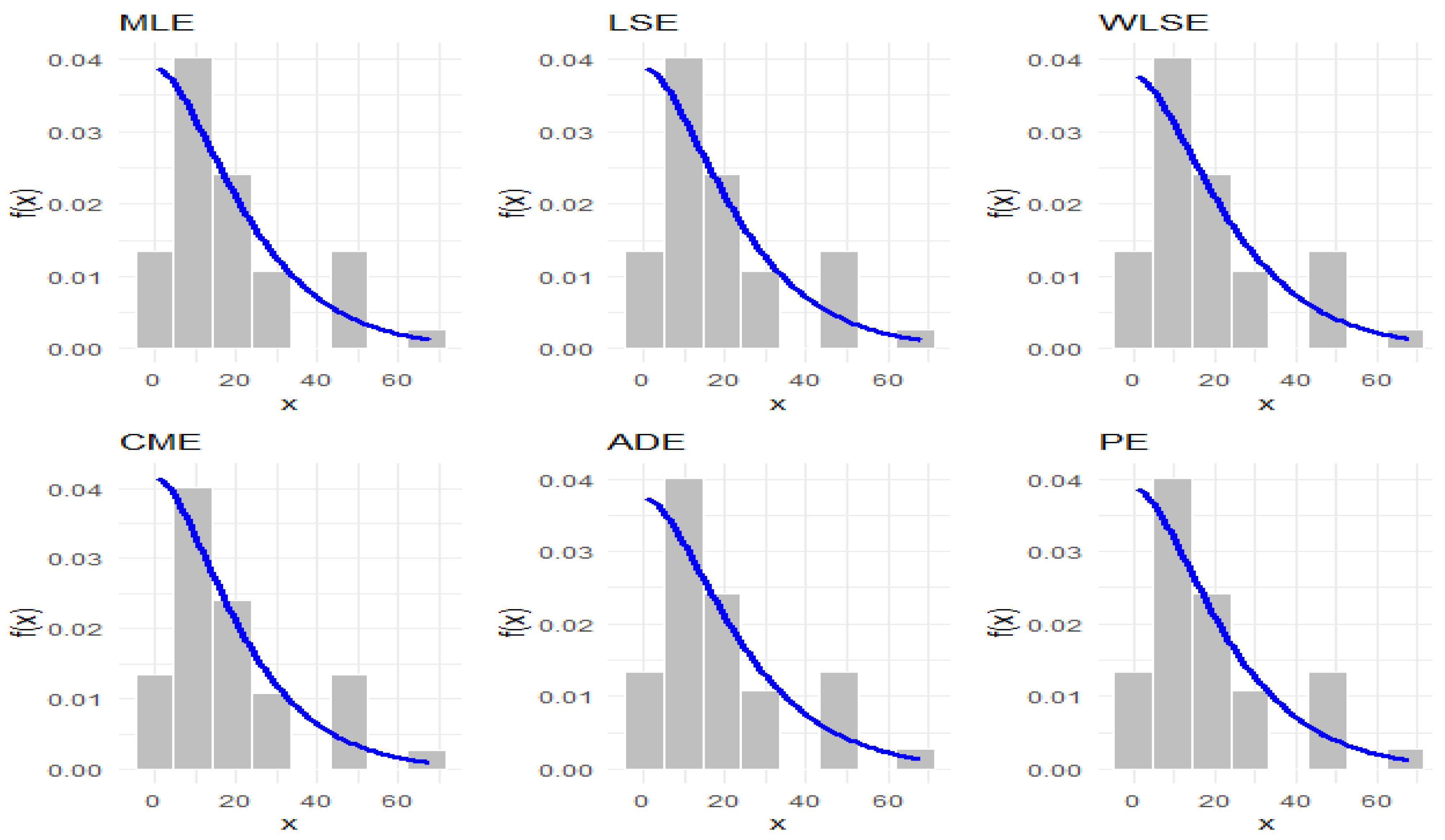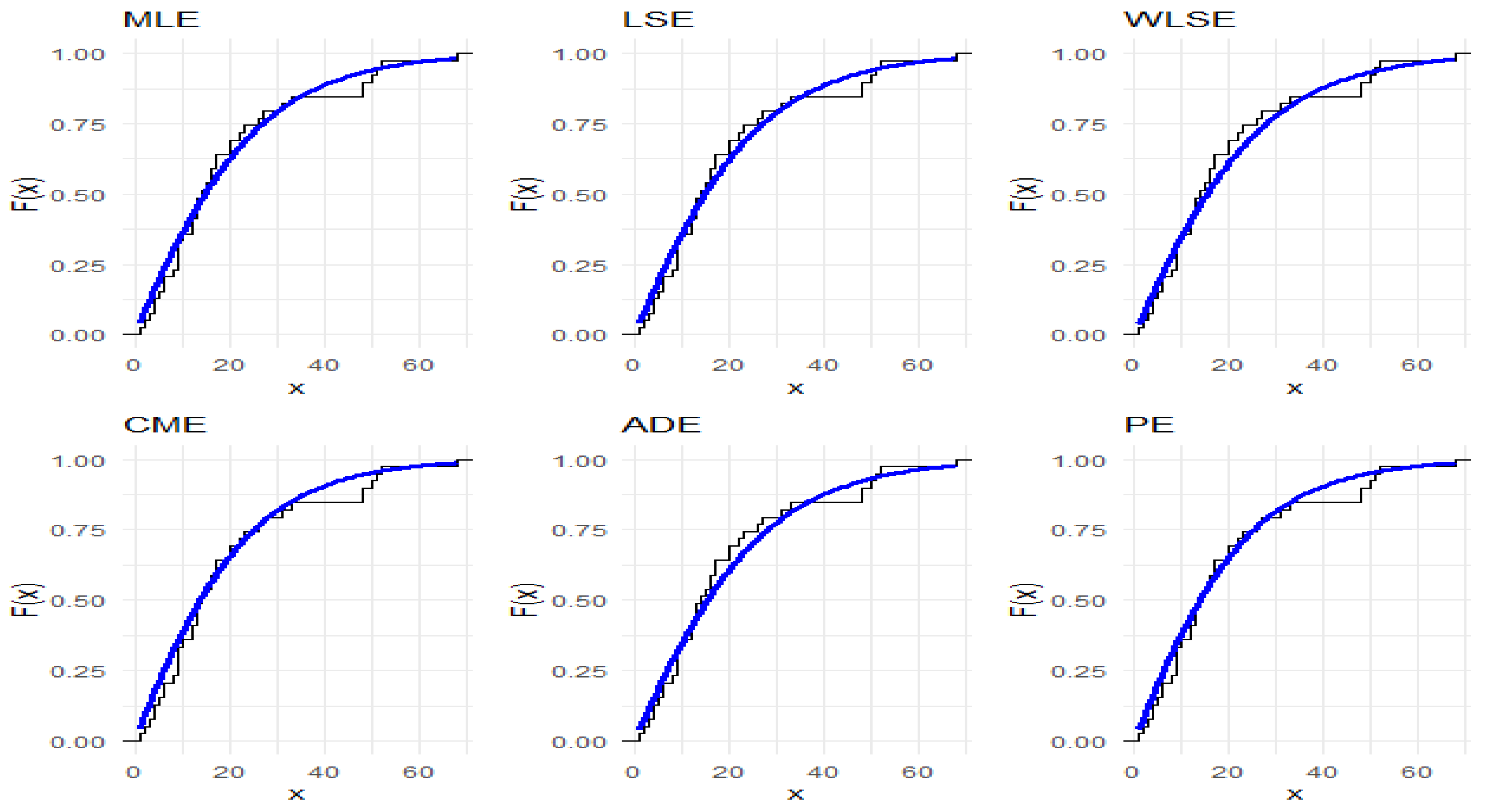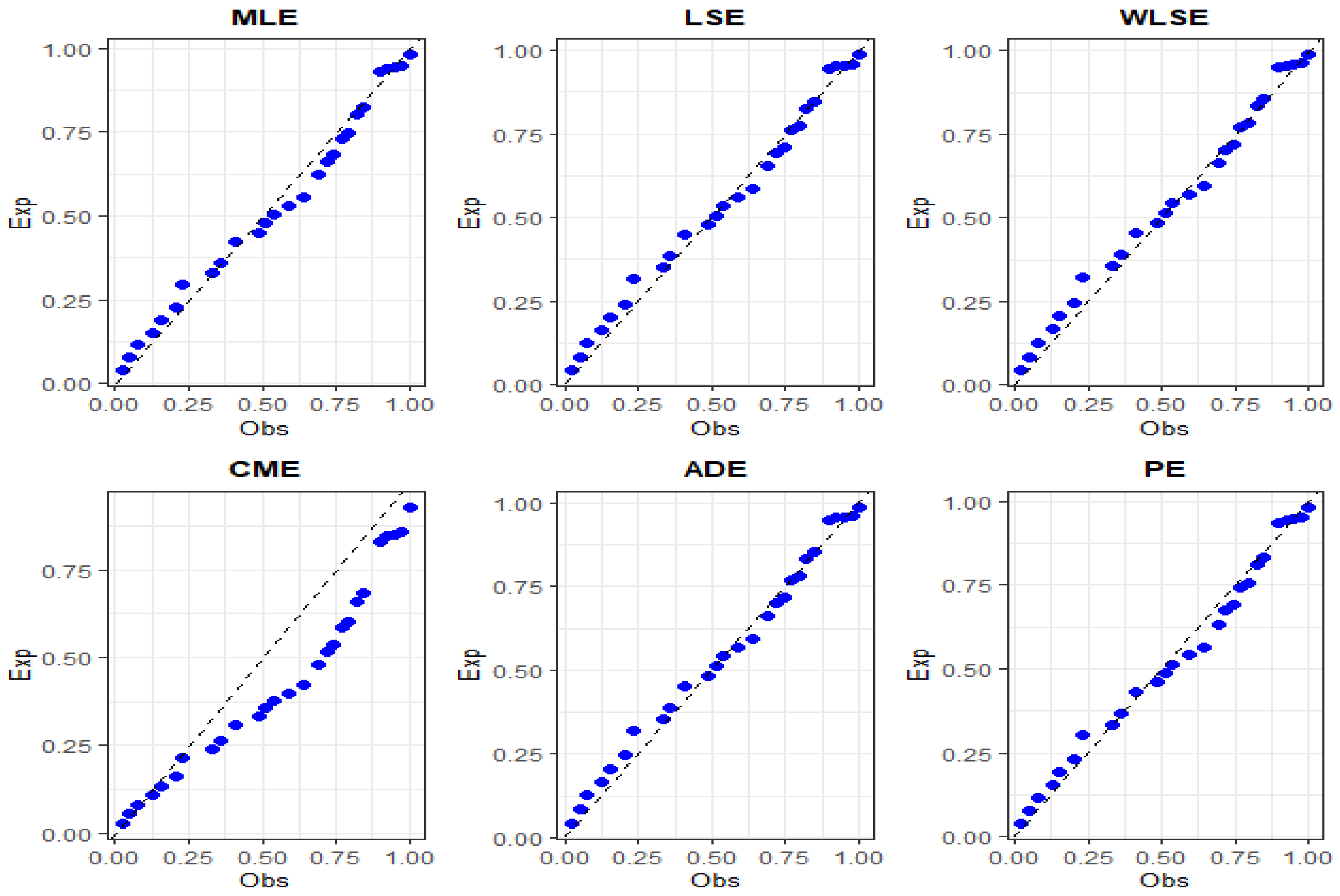1. Introduction
Over the past century, numerous important probability distributions have been developed to serve as models across various scientific disciplines. In recent years, there has been growing interest in creating new classes of univariate continuous distributions to enhance the flexibility and applicability of existing ones. An established probability model can be extended through various approaches, leading to a wide array of new distributions. Statistical analysis and data modeling are essential in nearly all applied fields, including biomedical research, engineering, finance, demography, environmental sciences, and agriculture. The statistical literature offers a rich collection of continuous distributions for modeling lifetime data, such as the exponential, Lindley, beta, gamma, Weibull, Gompertz, lognormal, and normal distributions, among others. Several techniques are available for generalizing probability models, including the mixture and transformation of existing distributions, the transmutation method, non-parametric approaches, the power method, and the exponential method.
One notable approach to generating new probability distributions is through the concept of weighted distributions. In such models, weights are introduced to modify conventional probability calculations, allowing the probability of an event to be determined not merely by counting the number of data points but by summing the weights associated with those data points. This approach provides greater flexibility in modeling complex datasets, as individual observations can exert varying degrees of influence on the overall distribution. The idea of weighted distributions was first introduced by Fisher [
1] and later extended by Patil and Rao [
2]. Formally, let
X be a random variable with probability density function (PDF)
f(
x), and suppose that the probability of observing
X = x is proportional to a non-negative weight function
. Then, according to the weighted probability principle, the density function of the observed
X is given by the following:
The probability density function obtained from this formulation is referred to as the weighted density, and the function
is called the weight function. The choice of
depends on the application, and various forms have been proposed in the literature. For instance, Mohiuddin et al. [
3] introduced the weighted Nwikpe distribution using a linear weight function, while Hussain and Mohammed [
4] applied an exponential-type weight in the weighted Zeghdoudi distribution. Ganaie and Rajagopalan [
5] considered a length-biased form in the new quasi-Lindley model, whereas Alsmairan and Al-Omari [
6] employed a quadratic-type weight in the weighted Suja distribution. Arnold and Nagaraja [
7] examined properties of bivariate weighted distributions, and Saghir et al. [
8] provided a comprehensive review of the field. Benchiha et al. [
9] proposed a generalized quasi-Lindley distribution under length-biased weighting, and Al-Omari et al. [
10] developed length- and area-biased versions of the Bilal distribution. These examples highlight the diversity of weight functions used in the literature, demonstrating how the choice of w(x) depends strongly on the intended application. Singh and Das [
11] considered a modified form of weighted distributions, referred to as the induced distribution, whose PDF is defined as:
where
is the expectation of the underlying random variable
X and
is the cumulative distribution function (CDF). Singh and Das [
11] used the induced distribution idea and suggested induced Garima distribution as a modification of the Garima distribution. In line with recent developments, several studies in 2024 have explored weighted and induced lifetime distributions in reliability and biomedical contexts. For example, Khan et al. [
12] and El-Morshedy and Ibrahim [
13] examined weighted and induced extensions of classical models, while Zhang and Chen [
14] discussed the role of residual life distributions in system reliability. Moreover, Ali et al. [
15] highlighted entropy-based measures in reliability modeling, and Hussain and Altaf [
16] emphasized the flexibility of new models for heavy-tailed biomedical data. These works demonstrate the growing importance of flexible lifetime models, supporting the relevance of our proposed distribution.
In this paper, we introduce a novel generalization of the Ailamujia distribution (ALD): the new weighted Ailamujia distribution (IALD). ALD was first introduced by Lv et al. [
17] as a statistical distribution to model lifetime data. Significant contributions have been added to ALD by Pan et al. [
18], Long [
19], and Li [
20]. Several authors have used ALD to develop and introduce many versions of statistical distributions with different characteristics; for example, the weighted Ailamujia distribution (WALD) (Jan and Ahmad [
21]), size biased Ailamujia distribution (Rather et al. [
22]), area biased Ailamujia distribution (ABALD) (Jayakumar and Elangovan [
23]), inverse analogue of Ailamujia distribution (Aijaz et al. [
24]), and power Ailamujia distribution (Jamal et al. [
25]).
The Ailamujia distribution, first highlighted in [
17], can be regarded as a particular case of the Erlang distribution with a shape parameter equal to 2 and rate parameter
. When parametrized as
= 1/γ with γ > 0, it is also known in the literature as the length-biased exponential (LBE) distribution [
26]. This model is mathematically simple, its probability density function (PDF) can exhibit right-skewed or bell-shaped forms, and its hazard rate function (HRF) is monotonically increasing. Hence, it provides a flexible alternative to classical one-parameter lifetime models, such as the exponential and Lindley distributions [
27]. The foundational properties of the Ailamujia distribution, including maximum likelihood estimation of its parameter, are detailed in [
17].
More recently, several generalizations have been introduced: an exponential transmuted version [
28], a Marshall–Olkin modification [
29], and an odd Weibull transformation applied to the LBE distribution [
30]. These variants have been utilized in practical applications, demonstrating that adaptations of the Ailamujia and LBE families are useful in modeling diverse datasets. Therefore, before introducing the proposed methodology, it is essential to revisit the main features of the Ailamujia distribution. Specifically, it is a univariate lifetime model for
> 0, defined by the cumulative distribution function (CDF)
where
is a scale parameter.
The corresponding probability density function (PDF) is quite simple; it can be written as below:
It is easy to verify that the mean and the standard deviation .
The novelty of this study lies in the introduction of the Induced Ailamujia Lifetime Distribution (IALD), which provides enhanced flexibility in modeling lifetime data. Unlike many existing models, the IALD can capture behaviors such as a monotonically increasing hazard rate that approaches a finite plateau. Furthermore, its superior goodness-of-fit in real biomedical in Ref. [
31] and industrial in Ref. [
32] datasets highlights its practical relevance. These features clearly demonstrate the necessity and advantages of the proposed model over traditional lifetime distributions.
Several new analytical properties are derived, including the quantile function, moments, moment generating function, probability weighted moments, and generalized entropies. Moreover, six estimation methods are examined through simulation to provide a robust inference framework. The model’s effectiveness is further validated using engineering and biomedical datasets, where it outperforms existing lifetime distributions, confirming its novelty and practical relevance.
The remainder of this paper is organized as follows.
Section 2 introduces the construction of the proposed model.
Section 3 derives and discusses several statistical properties of the proposed model, including moments, moment generating function, quantile function, probability weighted moment, Renyi entropy, and Tsallis entropy.
Section 4 describes six widely used parameter estimation techniques, while
Section 5 reports a simulation study designed to evaluate and compare the performance of six classical estimation methods. In
Section 6, the practical applicability of the IALD is demonstrated by fitting it, along with other competing models, to two real datasets and assessing their goodness-of-fit. Finally,
Section 7 provides concluding remarks and directions for future research.
4. Estimation Techniques
Six conventional techniques for estimating the parameter of the IALD are examined in this section. To obtain the most appropriate estimations, these estimating techniques maximize or minimize an objective function. These methods are the maximum likelihood (V1), least squares (V2), weighted least squares (V3), Cramér–von Mises (V4), Anderson–Darling (V5), and percentile (V6).
The V
1 approach was utilized on the IALD to estimate its parameter. Let
represent a sample of
values selected from the random variables
, which denote the lifespan of the data. Consequently, the likelihood function L is formulated as:
The log likelihood (l) function can therefore be expressed as follows:
By taking the first derivative to the function
with respect to the parameter
, we can find
We can use computing resources to determine the V1 estimates of the parameter by setting Equation (22) to zero.
Our chosen model estimator,
is obtained by reducing the following equation utilizing the V
2 estimation approach. More details on this approach can be found in Swain et al. [
36].
Our favorite model estimator,
is obtained by reducing the next expression employing the V
3 estimation technique. More details on this approach can be found in Swain et al. [
36].
The Cramér–von Mises estimator (V
4) is a goodness-of-fit based method that relies on the difference between the expected and the empirical cumulative distribution functions. Our suggested model estimator,
is obtained by reducing the following equation using the V
4 technique. See Choi and Bulgren [
37] for further information on this approach.
Our chosen model estimator,
is obtained by reducing the next equation applying the V
5 estimating approach. For further information on this approach, see Anderson and Darling [
38].
A distribution parameter can be estimated by using a closed-form distribution function, which plots a straight line against the percentile points. Kao [
39] and Kao [
40] suggested this method for figuring out the parameters of the Weibull distribution. In the distribution function, provided
random samples
where
indicates ordered samples, the V
6 estimates of the parameter
can be obtained by minimizing the following equation:
Denote by the unbiased estimator of The S6 estimation procedure involves differentiating Equation (23) with respect to , and equating the derivative to zero. Solving the resulting equation provides the estimate of the parameter.
5. Simulation Study
This section assesses the efficacy of the estimating methods discussed in
Section 4. The IALD was used to create simulated datasets, and the estimation techniques discussed were used to determine the unknown values. Two different metrics were used to evaluate the correlation performance: relative bias (RBIAS), and mean square errors (MSEs). To ensure robust inference, the parameters of the proposed IALD are estimated using six classical estimation methods: maximum likelihood, least squares, weighted least squares, Cramér–von Mises, Anderson–Darling, and percentile estimation. A comprehensive simulation study is conducted to evaluate the performance of these methods under varying sample sizes and parameter settings. The following describes how to use the inversion approach to gather random samples from the IALD:
The IALD yields random samples
of sizes;
25, 50, 75, and 100. We look at the values of
= 0.5, 0.8, 1.2, 1.5, 2, and 2.5. These parameter and sample size variables are used to evaluate the IALD’s estimates. For different parameter values, the estimations’ biases and mean squared errors (MSEs) are computed.
Table 2,
Table 3,
Table 4,
Table 5,
Table 6 and
Table 7 present the results of the empirical investigation. The following observations can be made based on these tables’ results:
The minimized biases and mean square errors (MSEs), which are tracked for its parameter, show that the IALD is steady.
Bias and MSE across all estimations can occasionally diminish when sample size grows.
All estimators’ bias and MSE values decrease with increasing sample size, indicating better model parameter accuracy for prediction.
The estimators show positive bias for all sample sizes.
Finding the best estimating strategy for the proposed model is the aim of the simulation study. The partial and total ranks for each estimation method are displayed in
Table 8. All of the parameter estimates techniques for the suggested model show excellent accuracy and closely resemble the genuine values, according to
Table 8’s results. As the sample size
grows, the computed metrics frequently decrease. With an overall score of 28, V
5 is determined to be the best effective parameter estimate technique. With a cumulative score of 67, the V
1 may be considered a competitor to the V
5 technique.
Although the derivations of the estimation procedures may appear mathematically demanding, the implementation of the IALD is straightforward in practice. The closed-form expressions of the PDF, CDF, and reliability measures can be easily programmed in standard statistical software such as R14, making the model accessible for applied researchers.
6. Applications
This section analyzes the versatility and significance of the IALD through the examination of two real-world datasets. The model’s effectiveness, demonstrated using data graphs, may be more compelling, as these graphical representations highlight the IALD’s enhanced ability to conform to the data in comparison to rival models. The practical significance is demonstrated by the examination of the air conditioning system failure times for a specific type of airplanes, and the number of vehicle fatalities in one of the provinces, which highlight the IALD’s superiority over alternative distributions. The proposed IALD will be relevant across various fields, including medical sciences, engineering, economics, and reliability research. The comprehensive overview of the datasets is encapsulated in the subsequent points:
The data originally acquired from Proschan [
31] indicates the failure times (in hours) of the air conditioning system for airplane 7913. This data is frequently utilized in reliability studies to predict and compare lifetime distributions, as well as to evaluate the efficiency of system elements throughout operating systems. Through the use of empirical data, this analysis emphasizes the effectiveness of the IALD in capturing complex machine failure behaviors, contributing meaningful insights for sectors where operational reliability and long service life are critical. The dataset is as follows: 1, 4, 11, 16, 18, 18, 18, 24, 31, 39, 46, 51, 54, 63, 68, 77, 80, 82, 97, 106, 111, 141, 142, 163, 191, 206, 216.
The second dataset, evaluated by Mann [
32], pertains to the total of automobile fatalities across 39 counties in South Carolina for the year 2012. The observations of the data are as follows: 22, 26, 17, 4, 48, 9, 9, 31, 27, 20, 12, 6, 5, 14, 9, 16, 3, 33, 9, 20, 68, 13, 51, 13, 2, 4, 17, 16, 6, 52, 50, 48, 23, 12, 13, 10, 15, 8, 1.
Table 9 primarily examines the two datasets.
Figure 4 and
Figure 5 present graphical summaries of the datasets through quantile–quantile (QQ) plots, violin plots, box plots, histograms, kernel density estimates, and total time on test (TTT) plots. The results suggest that the first dataset follows a right-skewed, non-normal distribution with the presence of outliers and a bathtub-shaped hazard rate function (HRF). Similarly, the second dataset also displays right skewness, several outliers, and a bathtub-shaped HRF. The IALD, as established in the theoretical findings, can accommodate these properties.
This comparative analysis thoroughly assesses the IALD against several competing models, namely the Ailamujia (AL) [
17], inverse power Ailamujia (IPAL) [
25], Ishita (ISH) [
41], generalized inverted exponential (GIEx) [
42], and Sujatha (SU) [
43] distributions. Parameter estimation and goodness-of-fit assessments were conducted using the maximum likelihood method within the R programming environment. The parameter estimates and their standard errors are reported in
Table 10 and
Table 11.
Model selection was based on a range of statistical criteria, including the Akaike information criterion (S
1), Bayesian information criterion (S
2), corrected Akaike information criterion (S
3), Hannan–Quinn information criterion (S4), Kolmogorov–Smirnov distance (S
5) with associated
p-value (S
6), and the Cramér–von Mises statistic (S
7). As shown in
Table 12 and
Table 13, the IALD outperforms all competitors, achieving the smallest values for S
1, S
2, S
3, S
4, S
5, S
6, and S
7, along with the largest value of S6. Additionally, graphical comparisons are presented in
Figure 6 and
Figure 7, which display fitted densities, empirical cumulative distribution functions, and P–P plots, while
Figure 8,
Figure 9,
Figure 10,
Figure 11,
Figure 12 and
Figure 13 offer visual comparisons of the two datasets with their corresponding fitted PDFs, CDFs, and P–P plots.
The comparative goodness-of-fit results confirm that the IALD consistently outperforms established lifetime models, including the Ailamujia, inverse power Ailamujia, Ishita, generalized inverted exponential, and Sujatha distributions. This superior performance is evidenced by lower values of AIC, BIC, HQIC, and Cramér–von Mises statistics, and higher K–S p-values, across both biomedical and industrial datasets.
7. Conclusions
In this study, we introduced the Induced Ailamujia Lifetime Distribution (IALD) as a flexible generalization of the Ailamujia distribution to overcome limitations in modeling complex lifetime and reliability data. The IALD can take a wide range of shapes, making it suitable for heterogeneous datasets where traditional models may fail. Several statistical properties were derived, including reliability measures, moments, quantile and generating functions, probability weighted moments, and entropy measures.
Different parameter estimation methods were applied and evaluated through simulation and real data analysis. The results confirmed the superior goodness-of-fit of the IALD compared to well-known lifetime models, underscoring its novelty and practical value in biomedical, engineering, and reliability studies. Finally, an important practical step is the development of software packages (e.g., in R14 or Python14) to provide user-friendly tools for density evaluation, parameter estimation, simulation, and goodness-of-fit testing, thereby enhancing the accessibility and applicability of the IALD in real-world research.
For future work, the IALD can be extended in multiple directions. Potential avenues include developing regression-type models, Bayesian inference approaches, and multivariate or hierarchical forms. Expanding comparisons to a broader range of distributions and applying the model to larger and more diverse datasets will further validate its robustness. Beyond reliability and biomedical studies, the IALD also shows promise in fields such as finance and social sciences, where data often displays skewness and heavy tails.
